How to Clean a Ping Pong Paddle
To clean your ping pong paddle, start by gently wiping it with a microfiber cloth to remove loose dust. Then, dampen a sponge with warm water and mild dish soap, wiping the paddle's surface in circular motions. For stubborn stains, use a toothbrush with rubber cleaning solution. Rinse off soap residue with a damp cloth, then dry thoroughly with a clean cloth. Allow the paddle to air dry completely before storing it in a protective case or wrapping it in a soft cloth. Regular cleaning maintains your paddle's performance and extends its lifespan. By following these steps, you'll guarantee your paddle remains in top condition for peak gameplay.
This post may contain affiliate links. If you make a purchase through these links, I may earn a commission at no additional cost to you. Additionally, portions of this post may be generated using artificial intelligence (AI) technology. While we strive for accuracy, please be aware that AI-generated content may not always be perfect and should be fact-checked when necessary.
The Spatula Scoops
- Wipe the paddle with a soft, lint-free cloth to remove loose dust and debris.
- Use a damp sponge with mild dish soap to clean the paddle's surface in circular motions.
- Remove soap residue with a clean, damp cloth, then dry thoroughly with a separate cloth.
- Allow the paddle to air dry completely in a well-ventilated area before use or storage.
- Clean regularly after use, avoiding harsh chemicals and excessive water to prevent damage.
Importance of Clean Paddles
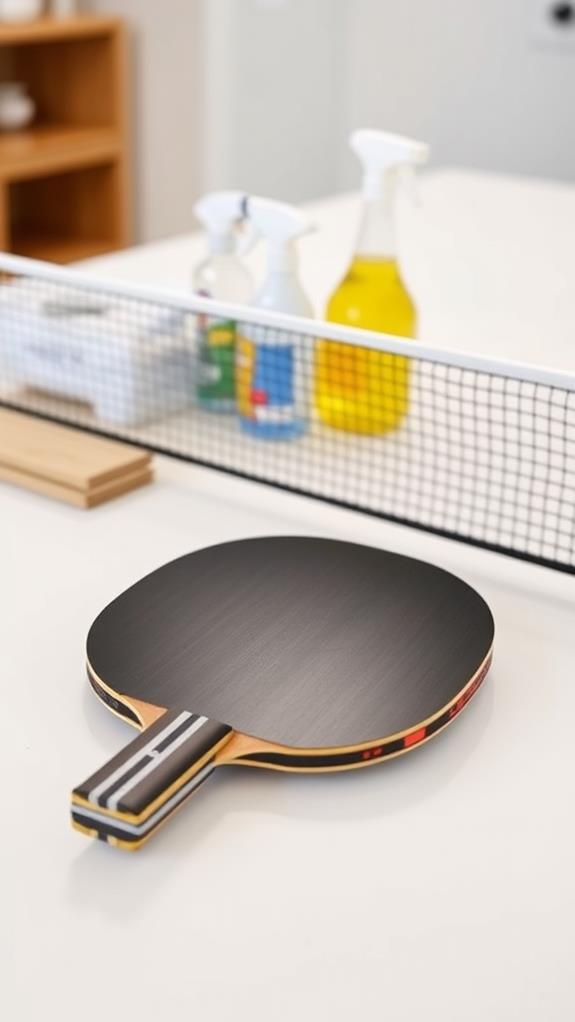
Many ping pong enthusiasts overlook the essential role of a clean paddle in their game. However, maintaining a clean ping pong paddle is imperative for peak performance and longevity of your equipment. When you play, your paddle accumulates dust, sweat, and dirt, which can substantially impact your grip, spin, and control. These elements can build up over time, affecting your gameplay and potentially causing irreparable damage to the paddle's surface. Just as a fine stainless steel zester maintains its sharpness over time with proper care, a well-maintained ping pong paddle can retain its effectiveness and performance.
Gathering Necessary Cleaning Materials
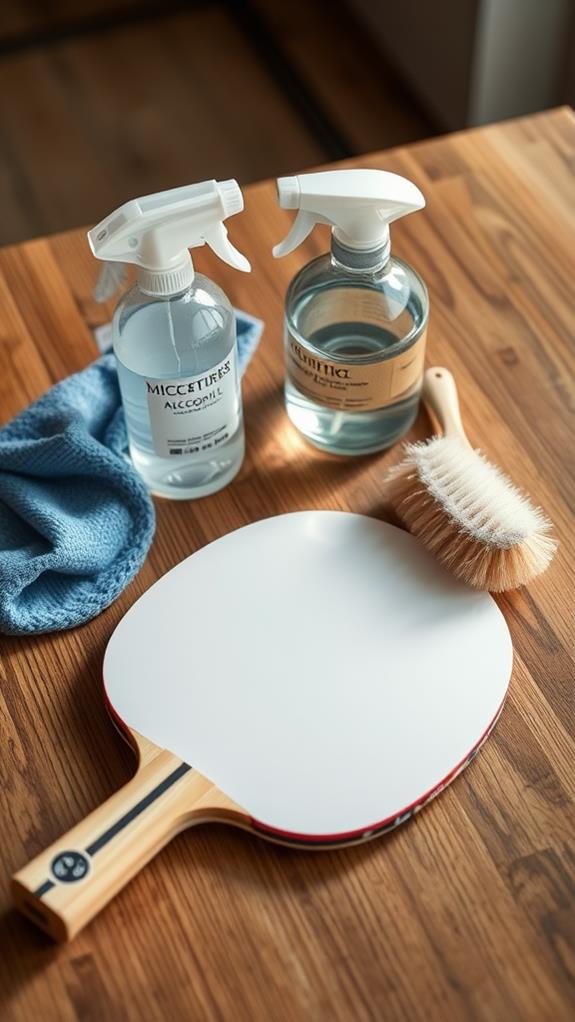
Before you begin the cleaning process, it's essential to gather all the necessary materials. You'll need a soft, lint-free cloth for wiping and dusting the paddle without causing any scratches. A gentle sponge is vital for applying soap and water to the paddle's surface. For tackling tough stains, you'll want to have some mild dish soap on hand, but remember to dilute it with water to avoid harsh chemicals.
You'll also need a bowl of warm water for dampening the sponge. Be sure the water isn't too hot or cold, as extreme temperatures can damage the paddle. Finally, choose a well-ventilated area for air-drying your paddle to prevent water spots.
| Material | Purpose |
|---|---|
| Lint-free cloth | Dusting and wiping |
| Gentle sponge | Applying soap and water |
| Mild dish soap | Cleaning tough stains |
| Bowl of warm water | Dampening sponge |
Step-by-Step Cleaning Process
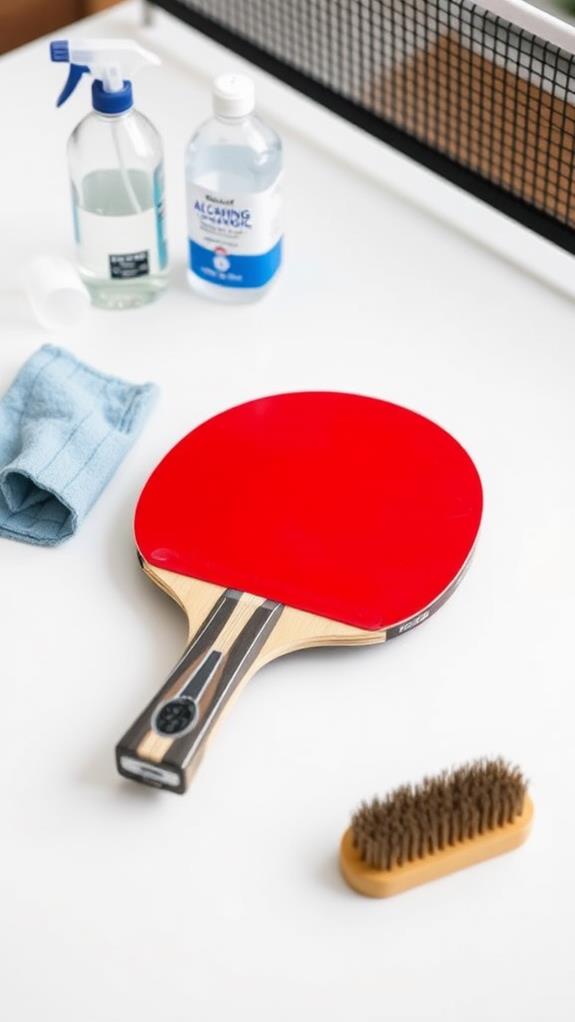
Now that you've gathered all the necessary materials, it's time to plunge into the cleaning process. Begin by gently wiping your ping pong paddle with a microfiber cloth to remove loose dust and debris. Pay special attention to the rubber areas, as they're vital for gameplay. If you're looking for a versatile tool to prepare ingredients for your post-game snack, consider the OXO Garlic Press, known for its efficiency and easy cleanup.
Next, dampen a sponge with warm water and add a small amount of mild dish soap. Carefully wipe down the paddle's surface using circular motions. Don't apply too much pressure or scrub too hard, as this could damage the rubber.
For stubborn stains or dirt buildup, use a toothbrush and a specialized rubber cleaning solution. Gently scrub the affected areas, taking care not to harm the rubber or surrounding surfaces.
After cleaning, use a clean, damp cloth to remove any soap residue and excess moisture. Finally, lay your paddle flat with the rubber side facing up and allow it to air dry completely. This step helps prevent water spots and potential damage to the rubber.
Drying and Storing Your Paddle
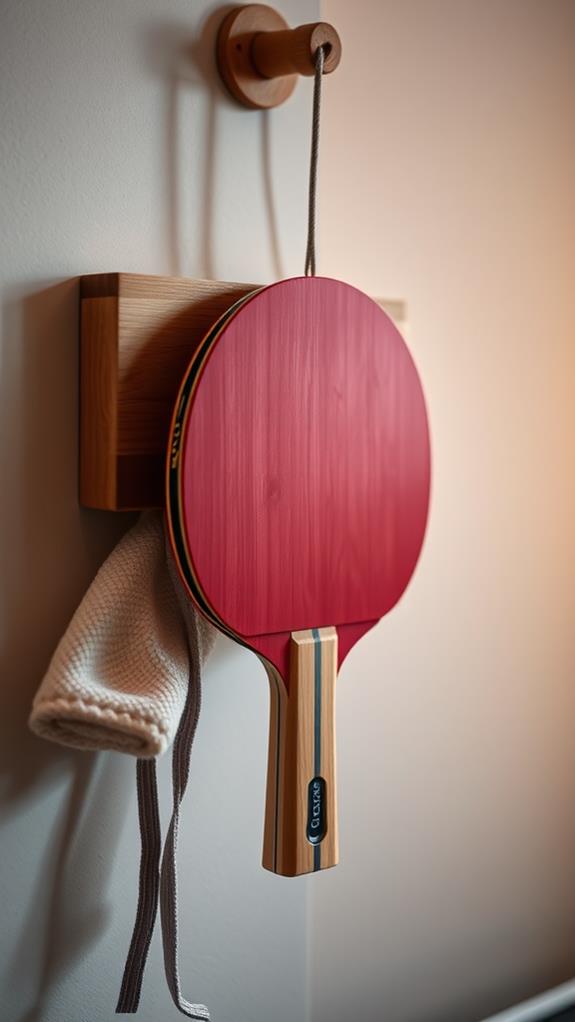
Proper drying and storage are crucial steps in maintaining your ping pong paddle. After you've cleaned your paddle, let it air dry completely before use or storage. Place it in a well-ventilated area, away from direct sunlight or heat sources. Don't use a hairdryer or other artificial heat, as this can damage the rubber surface. For efficient cleaning and drying of various kitchen tools, consider using a stainless steel ricer which is easy to clean and dishwasher safe.
Once dry, store your paddle in a protective case. This shields it from dust, moisture, and physical damage. If you don't have a case, wrap it in a soft cloth before placing it in your bag. Always store your paddle flat to prevent warping.
Remember to clean your paddle regularly, ideally after each use. This prevents the buildup of dirt and oils that can affect your gameplay. When storing for extended periods, check on your paddle occasionally to confirm it's not accumulating moisture or developing mold.
Maintaining Paddle Performance

Regular cleaning and proper storage are just the starting points for keeping your ping pong paddle in top form. To maintain peak performance, you'll need to go beyond basic care. Regularly inspect your paddle for signs of wear and tear, paying close attention to the rubber surface. If you notice any peeling or bubbling, it's time to replace the rubber.
| Frequency | Action | Purpose |
|---|---|---|
| Daily | Wipe down | Remove sweat and dirt |
| Weekly | Deep clean | Restore grip and spin |
| Monthly | Check rubber | Assess condition |
| Quarterly | Apply rubber cleaner | Extend rubber life |
| Annually | Replace rubber | Guarantee peak performance |
When cleaning your ping pong paddle to remove stubborn dirt, use a specialized rubber cleaner. This gentle solution will clean ping pong paddle surfaces without damaging the rubber. Apply the cleaner sparingly and wipe with a soft cloth. Don't forget to clean the handle and edges, as these areas can accumulate grime that affects your grip. By following these maintenance steps, you'll guarantee your paddle remains in top condition, allowing you to play at your best.
Common Cleaning Mistakes to Avoid
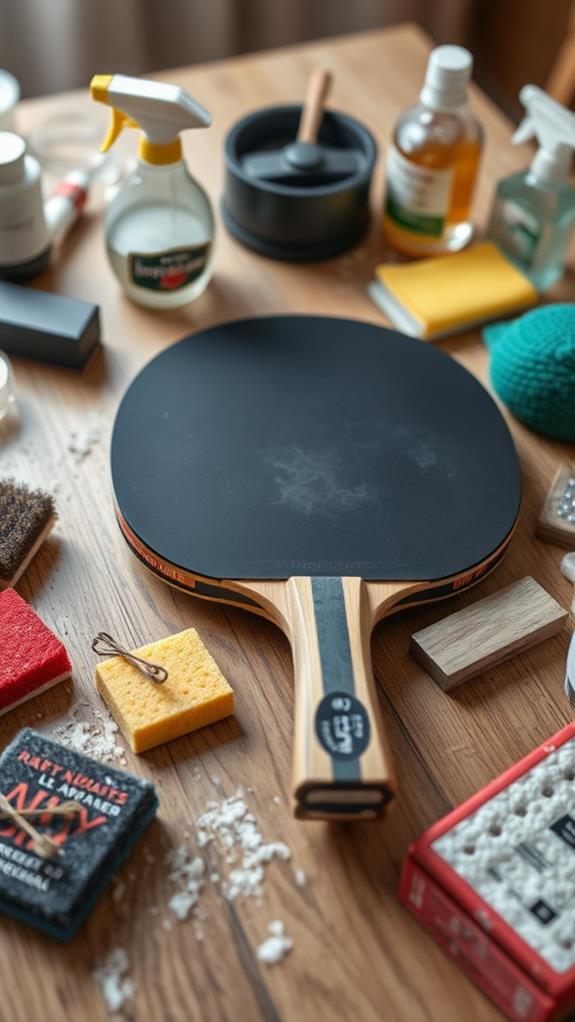
When cleaning your ping pong paddle, you'll want to steer clear of common mistakes that could damage its performance. Avoid using harsh cleaning agents, which can strip the rubber or damage the blade, and be cautious not to apply excessive water, as this can warp the wood or cause the rubber to peel. Much like the stainless steel spoon designed for heavy use, your ping pong paddle requires proper care to maintain its durability and functionality. It's vital to take into account your paddle's specific material composition, as different types of paddles may require unique cleaning approaches to maintain their integrity and playing characteristics.
Using Harsh Cleaning Agents
Despite the temptation to use strong cleaning agents, harsh chemicals can seriously damage your ping pong paddle. You might think that rubbing alcohol or dish soap will effectively clean your paddle, but these substances can strip away the rubber's protective layer and compromise its performance. Instead, opt for a gentle approach by using a slightly damp cloth to gently wipe the paddle's surface.
When cleaning your ping pong paddle, remember that less is more. A soft, lint-free cloth slightly moistened with water is usually sufficient to wipe away dirt and sweat residue. If you encounter stubborn stains, resist the urge to scrub vigorously or use abrasive materials. These actions can cause micro-tears in the rubber, reducing its grip and spin capabilities.
Avoid using any cleaning products containing solvents, bleach, or ammonia. These harsh chemicals can break down the adhesive that holds the rubber to the paddle's surface, leading to premature deterioration. By sticking to gentle cleaning methods, you'll extend the life of your paddle and maintain its ideal playing characteristics. Remember, proper maintenance is key to preserving your paddle's performance and longevity.
Excessive Water Application
Another common mistake in paddle cleaning is excessive water application. While it's tempting to use plenty of tap water to clean your ping pong paddles, this can actually damage the rubber surface and the wooden core. Too much water can seep into the paddle, causing warping, delamination, or even mold growth.
When cleaning your paddle, make sure to use only a slightly damp cloth or sponge. Avoid submerging the paddle or running it under a faucet. Instead, lightly moisten your cleaning tool and gently wipe the paddle's surface in a circular motion. This technique allows you to remove dirt and grime without oversaturating the paddle.
If you accidentally use too much water, immediately dry the paddle thoroughly with a clean, dry cloth. Pay special attention to the edges and any seams where water might collect. After wiping, let the paddle air dry completely before storing or using it. Remember, a little moisture goes a long way in cleaning, and excessive water can substantially shorten your paddle's lifespan. By using minimal water and proper drying techniques, you'll maintain your paddle's performance and longevity.
Ignoring Paddle Material
A crucial mistake many players make is treating all ping pong paddles the same when it comes to cleaning. Different materials require specific care, and ignoring this fact can lead to damage or reduced performance. Before you start cleaning, identify your paddle's composition.
For rubber surfaces, use a damp cloth with mild soap, gently wiping the side facing the ball. Avoid harsh chemicals or abrasive materials that could degrade the rubber's grip. If your paddle has a wooden handle or blade, be cautious with moisture. Excess water can warp the wood or cause the layers to separate.
For paddles with carbon fiber or composite materials, use specialized cleaners designed for these surfaces. These materials are sensitive to certain chemicals and may react poorly to standard cleaning solutions. When you start cleaning, always test a small, inconspicuous area first. This precaution helps guarantee the cleaning method won't harm your paddle's surface.
Remember to clean both sides of the paddle and repeat this process regularly to maintain peak performance. By tailoring your cleaning approach to your paddle's specific material, you'll extend its lifespan and keep it in top condition for your Table Tennis matches.
Frequently Asked Questions
How Do I Make My Ping Pong Paddle Sticky Again?
Did you know that a properly maintained ping pong paddle can last up to 5 years? To make your paddle sticky again, you'll need to clean and recondition it. Start by gently wiping the surface with a damp cloth. Then, apply a small amount of specialized rubber cleaner or a mixture of water and rubbing alcohol. Avoid harsh chemicals that can damage the rubber. Once cleaned, test the paddle's tack by dropping a ball from 3-4 inches above it. Regular maintenance will keep your paddle in top condition.
How Do You Clean Paddles?
To clean your paddles, start by gently wiping them with a soft, lint-free cloth to remove dust and debris. For tougher grime, use a damp sponge with mild dish soap, but avoid applying too much pressure. You can tackle stubborn stains with a mixture of a pea-sized drop of dish soap and 1-2 cups of water. Be careful not to use abrasive cleaners or excessive water on the rubber parts. Regular cleaning will help maintain your paddle's performance and extend its lifespan.
Can I Clean Table Tennis Rubber With Water?
Imagine a pristine table tennis rubber, smooth and tacky. Yes, you can clean it with water, but there's a right way to do it. Use warm, room-temperature water and a soft, damp cloth to gently wipe away dirt. Don't soak the rubber or use cold or hot water, as this can damage it. For tougher grime, you can add a tiny bit of mild dish soap to the water. Remember to dry the rubber thoroughly afterwards to prevent moisture buildup and bacterial growth.
How to Clean a Table Tennis Paddle Handle?
To clean your table tennis paddle handle, you'll want to start by wiping it down with a slightly damp cloth to remove surface dirt and sweat. Don't use too much water, as it can damage the wood. For stubborn grime, try a mild soap solution, but be careful not to let it seep into the paddle. After cleaning, dry the handle thoroughly with a clean towel. Finally, if your handle has a grip, consider replacing it periodically for ideal performance and hygiene.





